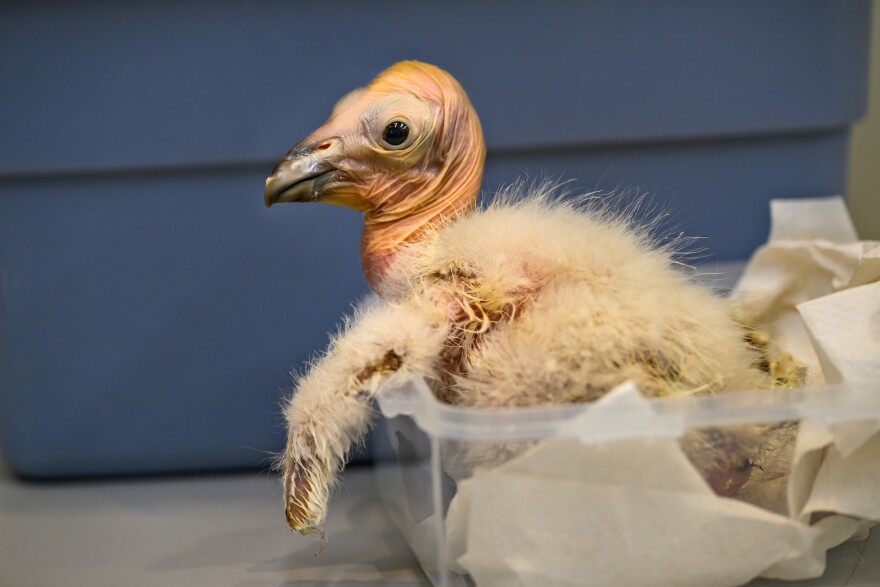Truth matters. Community matters. Your support makes both possible. LAist is one of the few places where news remains independent and free from political and corporate influence. Stand up for truth and for LAist. Make your year-end tax-deductible gift now.
LA Zoo hatches record number of California condor chicks

The Los Angeles Zoo is currently caring for a record-breaking 17 California condor chicks, and they could be released into the wild as part of an international recovery program for the critically endangered species.
This breeding season has blown past their previous record of 15 chicks hatched in 1997, and zoo officials say it’s a historic moment in the effort to save America’s largest flying bird from extinction.
Mike Clark, an L.A. Zoo animal keeper who’s worked with the California condors for about 35 years, told LAist the chicks have already started showing off their own personalities.
“The parents are all doing a great job,” he said. “They're growing like weeds, they're really a happy bunch of birds.”
How are they raised?
The first chick hatched in March, with the final one emerging last month, and zoo officials say they’re thriving.
The chicks are paired with surrogate parents so there’s minimal human interaction and they can learn from adult California condors, which Clark noted is critical for when they’re released in the wild.
“The birds are very, very inquisitive and very easily tamed, and very easily habituated to novel stimuli, including humans,” he said.
That technique is relatively new. Animal keepers used to hand-raise each and every chick that hatched at the zoo, but Clark said they realized those early social interactions with their own kind is a key factor for survival.
“If they didn't have the right sort of adult socialization, they really didn't know the language of the condor, and so they didn't do so well in the wild,” he said. “It's kind of a ‘Lord of the Flies’ type of thing — they had no structure to their lives.”
Some of the chicks are also grouped with other condor siblings, and this year was the first time the zoo placed three chicks with an adult female at the same time.
Clark said they’re matched based on their hatching date, the genetic value of the eggs, and how well the parents have cared for chicks in the past.
What’s next?
The zoo prefers to keep the chicks with their surrogate parents as long as possible, but with breeding season starting again as soon as December, they’ll be moved into a big group cage when they’re about six to eight months old.

They’ll stay in the “pre-release pen” until next September, during which they’ll learn how to live with other condors of all ages.
“They'll start their own hierarchy in this big group pen, and pretty much they're completely isolated from human contact,” he said.
They’ll then be moved to different field sites, such as Big Sur, the Pacific Northwest, and the Grand Canyon, where they’ll typically be released in the fall.
About California condors
In 1982, there were only 22 California condors left in the world.
In an effort to save the species, the U.S. Fish and Wildlife Service and the California Fish and Game Commission agreed to capture all of the wild condors and create a breeding program for the birds, which was underway about five years later.
The L.A. Zoo has cared for California condors for nearly 60 years, when Topa Topa was rescued as a malnourished fledgling. It’s also a partner of the program, and zoo officials say their focus has turned from building up their own breeding population to maintaining the wild birds that’ve been released across California.

As of last December, there was 561 California condors in the world, including 344 flying free in the wild, according to the L.A. Zoo.
But the species isn’t out of the woods yet, as they still struggle with habitat loss and lead poisoning from being “nature’s cleaning crew” and accidentally eating bullet fragments while scavenging deer and cattle carcasses.
Outbreaks of highly pathogenic avian influenza (HPAI) have also popped up across the country recently, further threatening their comeback.
Can I visit the chicks?
California condors aren’t on exhibit at the L.A. Zoo, but they offer two opportunities to see the birds for yourself.
If you head to the picnic area next to the Angela Collier World of Birds Show Theater, you can join Condor Spotting sessions from 12:30 p.m. to 1 p.m. each day, except on Tuesdays.
You can also get to know Hope, a non-releasable California condor, at the Angela Collier World of Birds Show at 12 p.m. daily, weather permitting. The show is also closed on Tuesdays.










